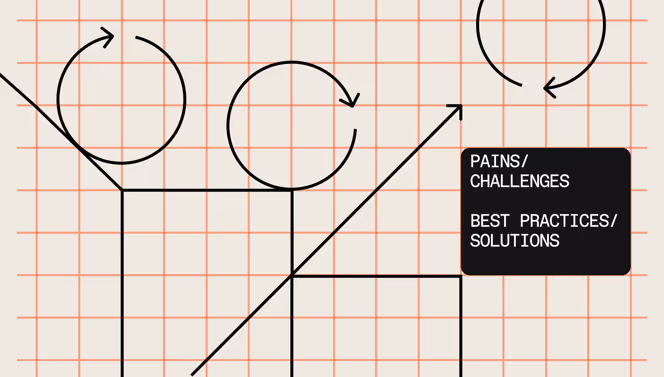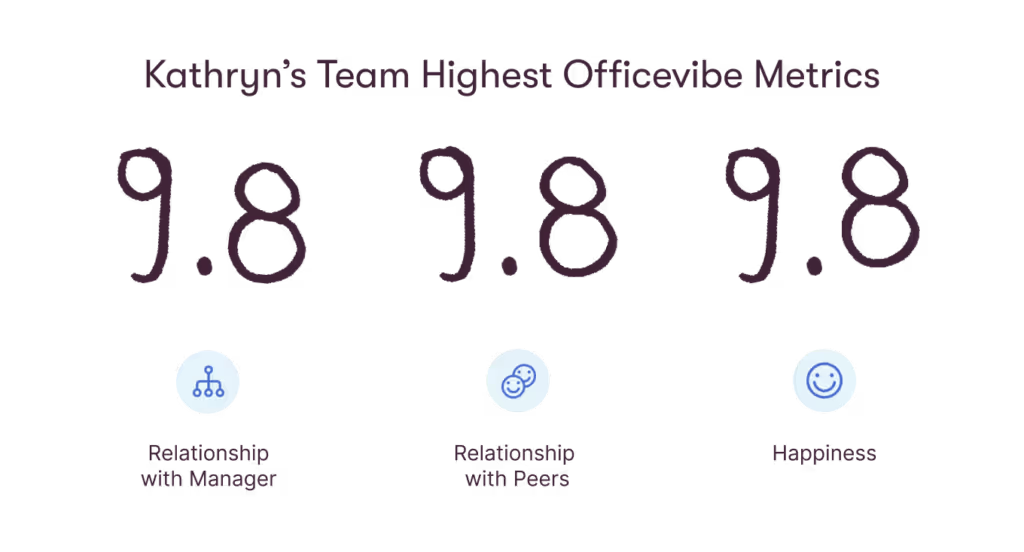Leveraging continuous performance management in the modern workplace

Discover Workleap Officevibe's benchmark report on 12 key employee engagement metrics

The modern workplace craves fresh, engaging, human-centered management approaches. The new wave of workers crave more connection and feedback, and less ambiguity. Traditional management methods are falling short of these meeting needs, leaving today's employees feeling disconnected and uncertain about their progress.
This is where continuous performance management comes in — embracing real-time feedback, fostering dynamic employee engagement, and promoting ongoing communication. It's a proven approach that offers a more dynamic and effective way to enhance team productivity and cultivate growth for individual employees.
Pains of traditional performance management in the modern workplace
Sticking to old ways of doing things can have its drawbacks, especially when it comes to traditional management methods. While some may be hesitant to embrace change, it's important to recognize the limitations of the traditional approach, namely:
- Infrequent feedback: With traditional management relying on annual or bi-annual reviews, employees are left in the dark about their performance for extended periods. This lack of real-time feedback makes it challenging for team members to make timely improvements and adjustments.
- Lack of employee engagement: Traditional methods often involve one-way communication from managers to employees, leaving little room for dialogue. This lack of engagement can make employees feel disconnected or misunderstood, ultimately impacting their motivation and productivity.
- Delayed problem identification and resolution: The infrequency of reviews means that performance issues may go unnoticed until the scheduled review period arrives. This delay in identifying problems and resolution can have a significantly negative impact on individual and team performance, as well as overall business outcomes.
By understanding the limitations of traditional management, we can explore a more effective and engaging alternative, which benefits your direct reports just as much as your entire organization.
Why continuous performance management is important
Continuous performance management is not just a trendy buzzword — it offers significant advantages and benefits for organizations and their employees. Thanks to real-time and continuous communication, we can see more immediacy when it comes to identifying, addressing, and fixing problems.
Benefits of continuous management performance
When nearly 1/5 of employees (17%) report leaving their jobs due to insufficient feedback, continuous performance management could be the answer to increasing employee retention rates. Recent studies also show its impact on employee performance — with companies who have effectively integrated performance management programs experiencing 1.25x higher productivity and 1.48x better financial outcomes.
All in all, having a continuous performance management strategy is a responsive way of working that provides winning outcomes for everyone, employees and organizations alike. But how?
By providing real-time continuous feedback, managers can drive immediate improvements in employee performance and foster a positive culture around ongoing learning and development.
Effective communication and understanding between employees and management are facilitated, leading to the resolution of issues before they escalate into major pitfalls. As a result, employee engagement and job satisfaction soar while individual goals align seamlessly with the organization's strategic objectives.
Plus, with access to current and comprehensive performance data, managers can make informed decisions that drive productivity and enhance competitiveness.
So, we say, Embrace the power of continuous performance management. It'll unlock your team's full potential and be a system that supports you in leading each of your direct reports in the right direction.
{highlight}
Make sure you're familiar with the principles of performance management. This approach uses employee performance as the starting point for the right conversations.
{highlight}
Defining continuous performance management
Continuous performance management is an ongoing performance review process that involves regular discussions between managers and employees. It goes beyond formal reviews and incorporates frequent one-on-one meetings, regular feedback provision, clear goal setting, and emphasis on learning and development opportunities.
See the performance management process as a way to bridge the gap between monthly, quarterly, or yearly evaluations with lightweight checkpoints that allow for more proactive performance improvement. It's not just about continuous feedback—it's about continuous alignment between the manager and the employee.
A comprehensive definition of continuous performance management
Continuous performance management can be defined as an ongoing process where managers and employees regularly discuss and review the employee's work, goals, and professional growth. It is a method of feedback and communication that happens consistently throughout the year, not just during formal reviews.
The key components and characteristics
This management style has a few key elements. You'll likely be able to integrate these easily into your existing approach.
For one, frequent one-on-one meetings are a must. This helps open the lines of communication between managers and employees, which builds trust and respect.
Just as essential as setting clear and transparent goals and expectations, providing regular feedback and recognition helps employees gauge where they are at in reaching said goals.
Aligning individual goals with organizational objectives also helps tie everything back to the greater picture of performance.
Lastly, leaning into every conversation as a learning and development opportunity is important. This is how the continuous performance loop comes to life.
{highlight}
Bonus: Certainly essential for modern executions is using and applying the right technology for tracking and managing performance. This will allow you to closely monitor employee goals and performance and ensure your team is productive and aligned with organizational goals.
{highlight}
The difference between traditional and continuous performance management
Continuous performance management offers a distinct departure from traditional methods; while traditional performance management relies on infrequent reviews and evaluations, continuous performance management is characterized by regular and ongoing feedback.
Unlike the one-way communication found in traditional approaches, continuous performance management encourages an ongoing dialogue between managers and employees. This more agile and responsive approach allows for quick adjustments and improvements, fostering a culture of employee growth and development.
TL;DR: Check out this handy table.
The need for a continuous performance management strategy
We've gone through the countless benefits of a continuous performance review process, but here are a few more reasons to get behind this strategy:
We're in an era of evolving business dynamics and work culture
Modern businesses are fast-paced and constantly changing, so there is a greater need to keep up. More frequent performance reviews help stay aligned compared to once-a-year sit-downs.
The rise of remote work also demands more regular communication and feedback, to ensure all employees feel connected and engaged after the loss of organic interaction.
Most of all, Millennial and Gen Z employees value continuous learning and regular feedback, rendering traditional systems like annual reviews less effective and appealing.
Real-time feedback has real advantages over annual reviews
Real-time feedback allows for immediate course correction, leading to higher productivity and effectiveness, instead of waiting longer than necessary to improve on something.
This approach reduces the anxiety and stress often associated with annual performance reviews. Smaller but more frequent bits of feedback feel less daunting than a one-time, very long talk.
This type of feedback creates a more open and transparent work environment, increasing trust and collaboration between employees and managers.
With real-time feedback, employees feel more connected to their work and the organization because they feel more looped in, which helps boost morale and job satisfaction.
Continuous performance management fosters employee engagement and productivity
Regular interactions and feedback show employees that the organization values their work and development, increasing engagement. Happy employees equals a happy employer!
The continuous feedback loop helps employees understand their strengths and areas for improvement. There are always new milestones to get excited about reaching, which leads to higher productivity.
It aligns individual goals with organizational objectives, keeping employees focused and motivated, and feeling proud when their efforts are recognized.
It also encourages a culture of continuous learning and development, contributes to employees' personal and professional growth, and fosters collaboration.
Best practices for implementing continuous performance management
To effectively implement continuous performance management in your organization, it is crucial to follow best practices that promote clear communication, ongoing feedback, employee development, the use of technology, alignment with business outcomes, a feedback culture, and integration with recognition and rewards.
By adopting these practices, you can create a supportive and growth-oriented environment that propels your team's performance and drives your organization's success.
Ensuring clear communication about expectations
Communication is key when it comes to setting clear expectations. As a manager, it's important to define measurable goals for employees, providing them with a clear sense of direction. Regular one-on-one meetings offer the perfect opportunity to discuss expectations and objectives, ensuring everyone is on the same page. By outlining a clear pathway for career progression and opportunities within the organization, you inspire your employees to strive for excellence and reach their full potential.
Encouraging ongoing feedback and conversation
Building a culture of continuous feedback and conversation is essential for fostering growth and improvement. By scheduling regular check-ins, you create a supportive environment where feedback flows freely. Encourage open and honest dialogue, emphasizing that feedback is an opportunity for learning and development, rather than criticism. By cultivating a culture of continuous learning where feedback is embraced and valued, you empower your employees to constantly improve and reach new heights of success.
Prioritizing employee development and training
Investing in your employees' development and training is a win-win strategy. Establishing individual development plans allows you to tailor growth opportunities to each employee's unique needs and aspirations. By offering training programs and resources, you provide them with the tools and knowledge to enhance their skills and capabilities. Encourage employees to take on new challenges and responsibilities, supporting their growth and creating a culture of continuous improvement.
Leveraging technology for effective continuous performance management
In today's digital age, technology plays a crucial role in driving effective performance management. By using performance management software, you can effortlessly track goals, provide feedback, and monitor progress. Communication tools facilitate regular check-ins and discussions, fostering real-time collaboration and feedback. Data analytics offer valuable insights into employee performance, enabling data-driven decision-making and informed actions to optimize performance and drive results.
Aligning continuous performance management with business outcomes
To maximize the impact of continuous performance management, it's vital to align individual employee goals with broader organizational objectives. Regularly reviewing and adjusting goals ensures they remain relevant and aligned with changing business needs. During performance discussions, emphasize the connection between employee contributions and the success of the company, reinforcing the value of their work. You create a unified and purpose-driven work environment by aligning individual efforts with overarching business outcomes.
Promoting a feedback culture
Creating a feedback culture is crucial for continuous improvement and building strong relationships. Encourage feedback not only from managers to employees but also between peers and from employees to managers. This fosters a culture of mutual respect, where everyone has a voice and ideas are valued. Provide training and resources on effective feedback practices, equipping your team with the skills to communicate constructively. By promoting open communication and reducing misunderstandings, you lay the foundation for a supportive and collaborative work environment.
Integrating with recognition and rewards
Recognizing and rewarding high performance is a powerful motivator that fuels employee engagement and morale. In the context of continuous performance management, it's important to acknowledge and reward achievements and improvements in real time. Implement a fair and transparent recognition and reward system that aligns with the company's values and goals. By leveraging both intrinsic and extrinsic motivators, such as personal development opportunities and bonuses, you create a culture that celebrates success and inspires continuous excellence. Be creative in designing ways to foster a culture of recognition, whether in-person or in virtual settings, to ensure that achievements are celebrated and appreciated.
Case study: Frequent feedback is a key part of a solid performance management system
At Modern Marketing & Commerce (MMC), a New York-based company that helps businesses grow through digital strategies and optimization, the absence of a formal process for productive one-on-one conversations posed challenges to their performance management.
That's when they discovered Officevibe, a comprehensive platform that revolutionized their continuous performance management journey. Officevibe provided MMC with a centralized hub to streamline its performance management process, facilitating frequent feedback and fostering a culture of open communication.
One place for their continuous performance management process
The impacts and outcomes were remarkable. With Officevibe, MMC experienced increased team performance and satisfaction. Employees felt more engaged and valued, leading to heightened motivation and productivity.
By leveraging Officevibe's metrics and analytics, MMC gained valuable insights into individual and team performance, enabling data-driven decision-making for better outcomes.

{highlight}
Discover the full success story of MMC and Officevibe's transformative impact on team performance and satisfaction.
{highlight}
Potential challenges and solutions when you implement continuous performance management
Overcoming challenges is essential for the successful adoption of continuous performance management. Managers need practical solutions to navigate these hurdles, from resistance to change and time constraints to feedback quality and overemphasis on metrics.
Challenges encountered in adopting continuous performance management
Adopting a new approach to performance management can present a few challenges.
Some employees and managers may be resistant to change, as they are accustomed to traditional methods. Time and resource constraints can also be a hurdle, as regular check-ins and feedback sessions require a commitment from both parties. Additionally, ensuring the quality of feedback can be a challenge, especially if managers lack proper training. Another potential challenge is the overemphasis on quantifiable metrics, which may overshadow important qualitative aspects like interpersonal skills, creativity, and leadership qualities.
Practical solutions and strategies to overcome these challenges
It's important to implement practical solutions and strategies to overcome these challenges.
Effective change management involves communicating the benefits of continuous performance strategies, providing training and support, and addressing concerns promptly. Streamlining scheduling through the use of tools and software can help make regular check-ins more efficient and manageable. Training programs can equip managers with the skills to deliver constructive, actionable feedback, while also providing employees with guidance on how to receive and utilize feedback effectively. It's crucial to balance evaluation by incorporating qualitative and quantitative factors, ensuring a comprehensive view of an employee's performance.
The future of performance management
The future of performance management is, without a doubt, being influenced by remote and flexible work trends. Regular communication, digital tools, autonomy, and trust are (not surprisingly) becoming increasingly important. Advancements in AI, enhanced employee involvement, and a shift away from the annual performance review are driving improvements in performance management practices.
All these changes can drive continuous improvement and foster a culture of growth and well-being in organizations when used correctly.
Influence of remote and flexible working trends on continuous performance management
Regular communication becomes vital to keep teams aligned and engaged as remote and flexible work schedules gain prominence. We can no longer rely on organic opportunities to connect, as hybrid work systems require adaptation.
Embracing digital tools for efficient remote performance management enables seamless tracking and feedback. It eliminates manual processes, emphasizing outcome-based approaches for fostering trust, autonomy, and self-management. Employees desire to be empowered to step into success.
{highlight}
Our tip to catching the wave: Stay connected, embrace technology, and cultivate a flexible work environment that thrives on trust.
{highlight}
Potential advancements and improvements in continuous performance management practices
Exciting developments lie ahead for continuous performance management. AI and analytics, for instance, will play a key role in delivering real-time feedback, personalized training suggestions, and accurate performance predictions. But that's only the beginning.
Managers should also get ready for a more inclusive approach to performance management, as employees participate through self-assessments and peer feedback. The focus is shifting towards holistic employee well-being, considering mental health and work-life balance alongside traditional metrics.
These advancements promise to empower teams, enhance efficiency, and foster a supportive work environment. It's about humans working better with each other, for each other.
Supplementing the annual performance review process
As the continuous performance approach becomes the norm, it'll be crucial that you align with the shift toward more frequent reviews.
By supplementing the annual review (which can be mismanaged) with more frequent conversations, you'll foster a culture of continuous improvement, where learning and growth are valued. This shift cultivates sustained improvements in performance, empowering teams to reach new heights. Here's to constant communication and continuous development!
Revolutionizing work: Embrace continuous performance management
Continuous performance management is a game-changer that brings real-time feedback, dynamic engagement, and ongoing communication to the forefront. Its benefits are countless: quicker performance improvements, enhanced collaboration, swift conflict resolution, heightened employee satisfaction, a culture of growth, goal alignment, data-driven decision-making, and increased productivity. To succeed, prioritizing clear communication, ongoing feedback, employee development, tech integration, business alignment, feedback culture, and recognition will cover your bases.
With remote and flexible work trends shaping the future, having an effective performance management strategy is a must-have. Embrace it, evolve, and thrive in the workplace!
FAQ: Essential insights on continuous performance management
What is continuous performance management, and how does it differ from traditional performance reviews?
Continuous performance management is an ongoing process where managers and employees regularly discuss performance, goals, and development. It's not at all like traditional performance appraisals. Instead of annual or bi-annual checkpoints, it favors frequent check-ins, real-time feedback, and continuous goal setting. It's an adaptive approach that fosters a dynamic and responsive work environment, allowing for immediate adjustments and ongoing development rather than focusing on past performance.
How can technology be leveraged in continuous performance management?
Technology is crucial in facilitating continuous performance management — especially today. Performance management software enables you to track goals, provide real-time feedback, and monitor progress at the snap of a finger (or the click of a button). Data analytics also provide insights into performance trends and help greatly in making informed decisions. Tech tools aren't technically needed to manage performance continuously, but they make a world of a difference.
What are the key challenges of implementing a continuous performance management strategy, and how can they be overcome?
Implementing any new strategy always presents challenges, including resistance to change, ensuring consistency, gaining buy-in from managers and employees, and making sure everyone gets the right training. However, overcoming these challenges starts with clear communication and involving all parties in the process from Day 1.
Can a continuous performance management process be adapted for remote teams?
Absolutely. In fact, some managers see it as essential to remote management. Because continuous performance management emphasizes regular communication and feedback, it ensures virtual check-ins and progress monitoring don't fall by the wayside, regardless of location. By leveraging performance management software, managers can ensure that remote employees feel connected, engaged, and supported online all the time.
How often should feedback be given in a continuous performance management system?
Feedback should be given regularly, ideally in real-time (or as close as possible to the relevant event). Frequent constructive feedback helps employees make immediate improvements, and structured weekly or bi-weekly check-ins are a great complement to ad hoc check-ins, so all bases get covered.
Give HR and managers the clarity, confidence, and connection to lead better every day.


%20(1).avif)


.avif)
.avif)








